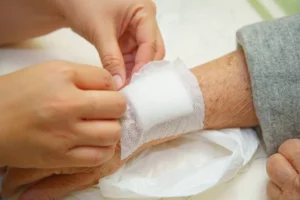Different populations present unique challenges in wound care, necessitating tailored approaches to dressing selection.

Pharmacists play a crucial role in optimising wound care. Selecting the appropriate dressing depends not only on the wound itself but also on the specific needs of the patient.
PAEDIATRICS
- Challenges: Fragile skin, high exudate absorption rate, fear/anxiety, diaper region contamination risk.
- Dressings: Hydrocolloids (gentle adherence), foams (absorbent), transparent films (monitoring), silicone dressings (painless removal).
- Considerations: Age-appropriate designs, minimising pain during dressing changes, ensuring secure adhesion despite movement.
IMMUNOCOMPROMISED PATIENTS
- Challenges: Weakened immune system, increased infection risk.
- Dressings: Antimicrobial dressings (reduce bacterial burden), hydrocolloid or alginate dressings (promote moist wound healing).
- Considerations: Prioritise infection prevention, minimise dressing changes to reduce manipulation of the wound bed.
GERIATRICS
- Challenges: Dry, fragile skin, limited dexterity, potential for cognitive decline.
- Dressings: Hydrocolloids (protect dry wounds), hydrogels (maintain moisture), transparent films (easy monitoring).
- Considerations: Ease of use for patients or caregivers, minimising dressing changes to reduce discomfort. Consider the presence of comorbidities such as diabetes, vascular disease, and immobility when selecting wound dressings for this population.
DIABETIC PATIENTS:
- Challenges: Impaired circulation can slow healing, increased risk of infection, neuropathy may reduce sensation in feet.
- Dressings:
- Moist wound healing: Hydrogels (promote moisture), hydrocolloids (absorb exudate, maintain moist environment).
- Offloading pressure: Consider dressings for pressure relief on foot ulcers (e.g., foam dressings).
- Antimicrobial properties: Dressings with silver or honey-based formulations can promote antimicrobial activity and may be beneficial for some infected wounds.
- Considerations: Diabetic patients are prone to developing chronic wounds, particularly foot ulcers, due to peripheral neuropathy and impaired circulation Prioritise maintaining a moist wound environment for optimal healing. Select dressings that minimise pressure on high-risk areas like the feet. Additionally, offloading devices such as specialised diabetic shoes or pressure-relieving dressings may be necessary to prevent further tissue damage. Be cautious with antimicrobials; use only under physician guidance to avoid antibiotic resistance.
ADDITIONAL CONSIDERATIONS
- Pain management: Adhesive dressings can be painful on removal. Consider silicone dressings or atraumatic borders for sensitive skin.
- Exudate level: Match the dressing's absorbency to the amount of drainage.
- Skin integrity: Protect surrounding healthy skin from moisture or irritation with barrier creams or films.
REMEMBER
- Patient education is key. Instruct patients on proper dressing application and signs of infection.
- Collaboration with healthcare providers ensures a comprehensive wound care plan.
- Stay updated on advancements in wound dressings for better patient outcomes.
By understanding the unique needs of different populations, pharmacists can recommend appropriate wound dressings and contribute to optimal wound healing.









